Hutchspace
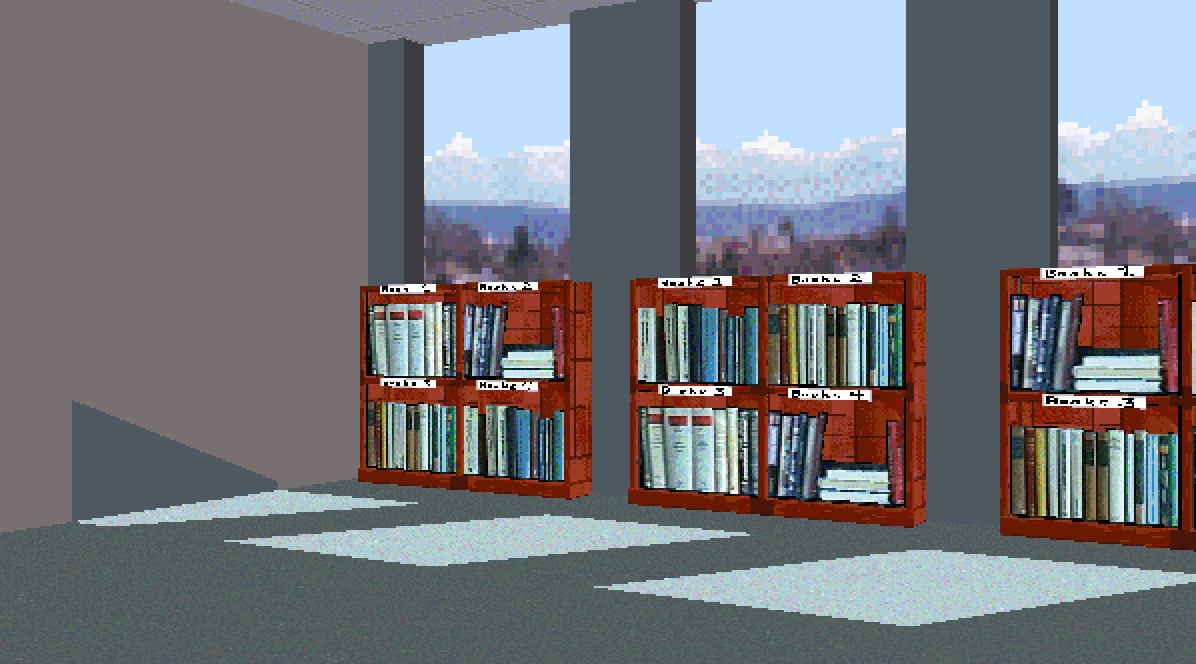
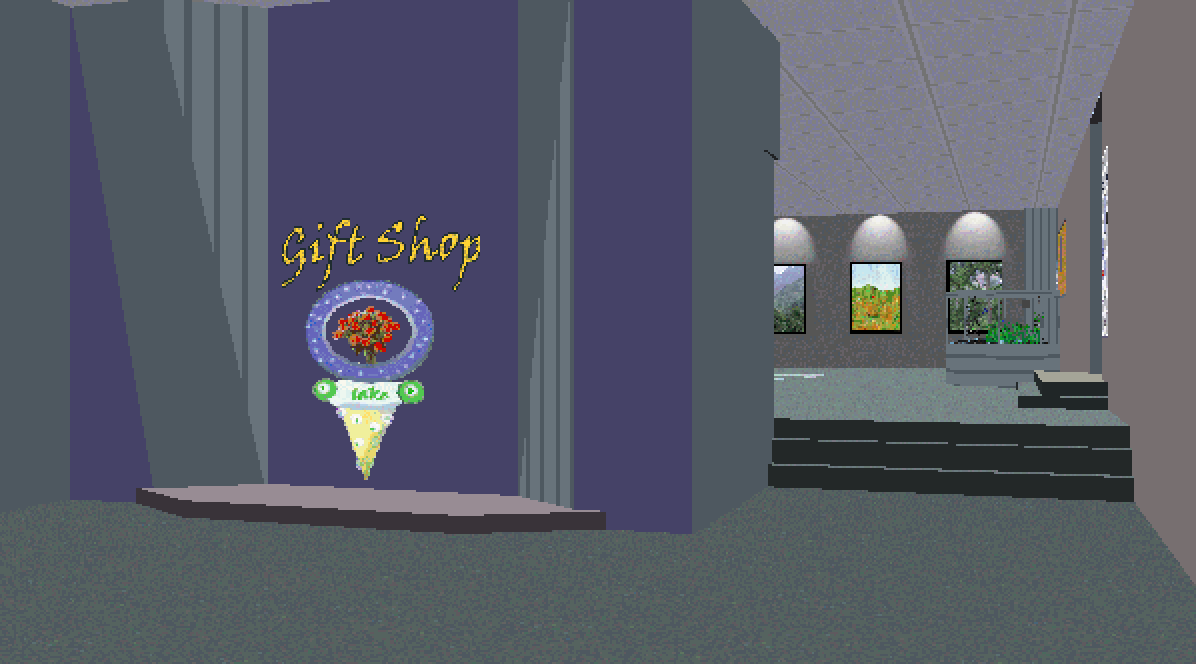
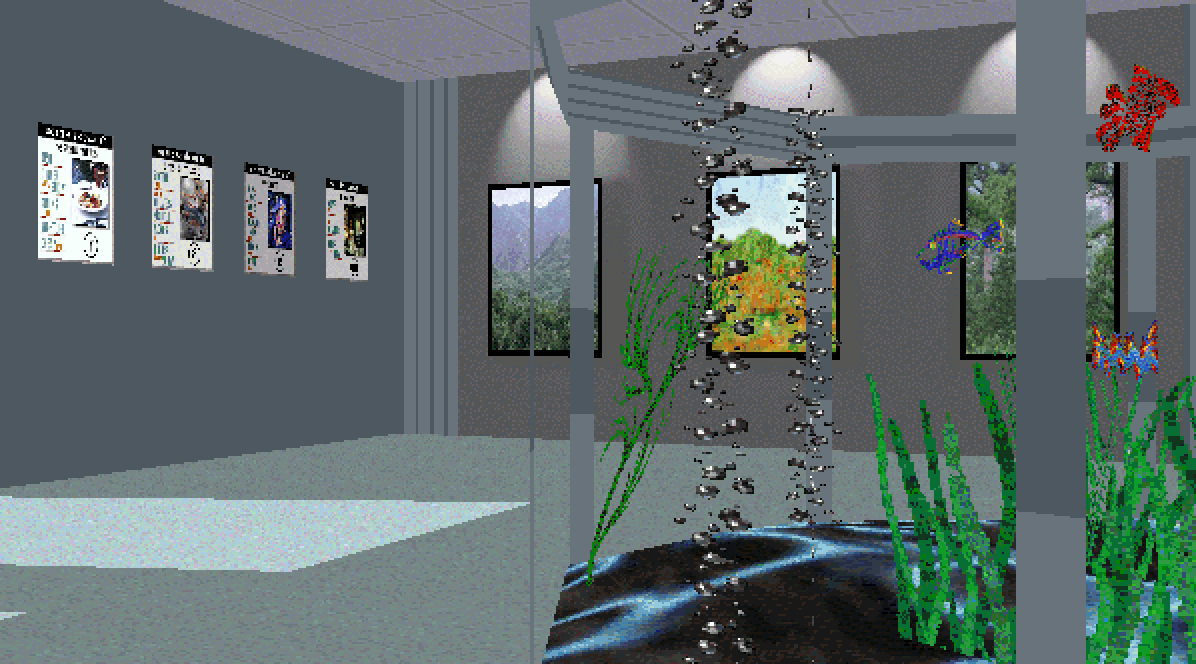
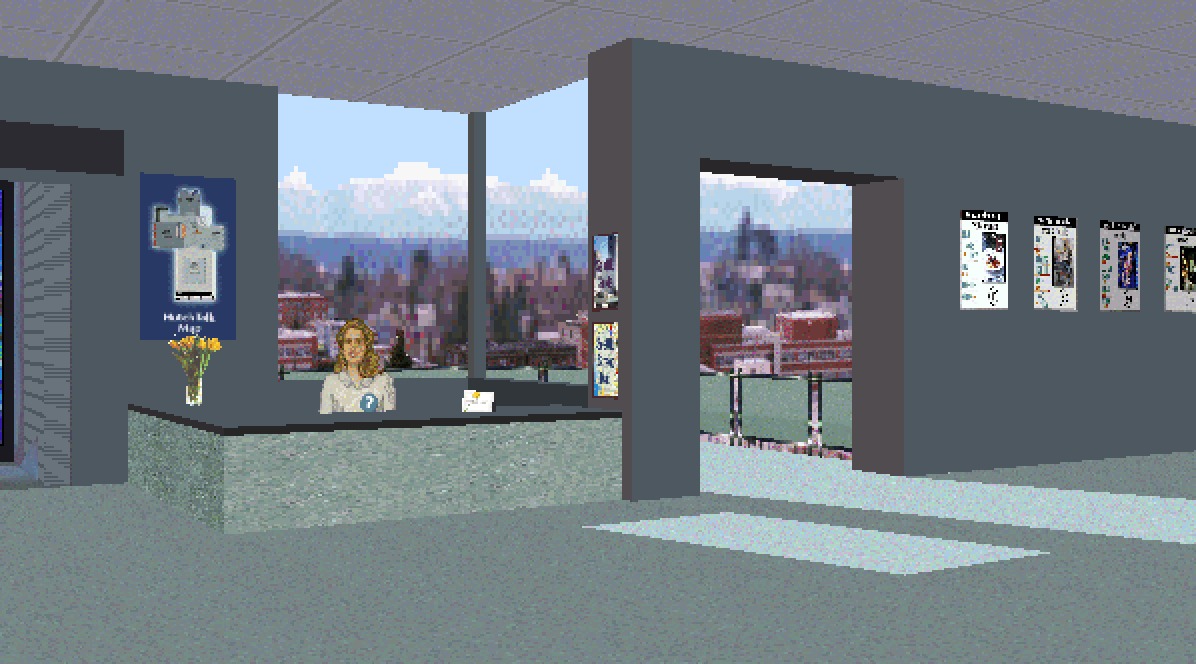
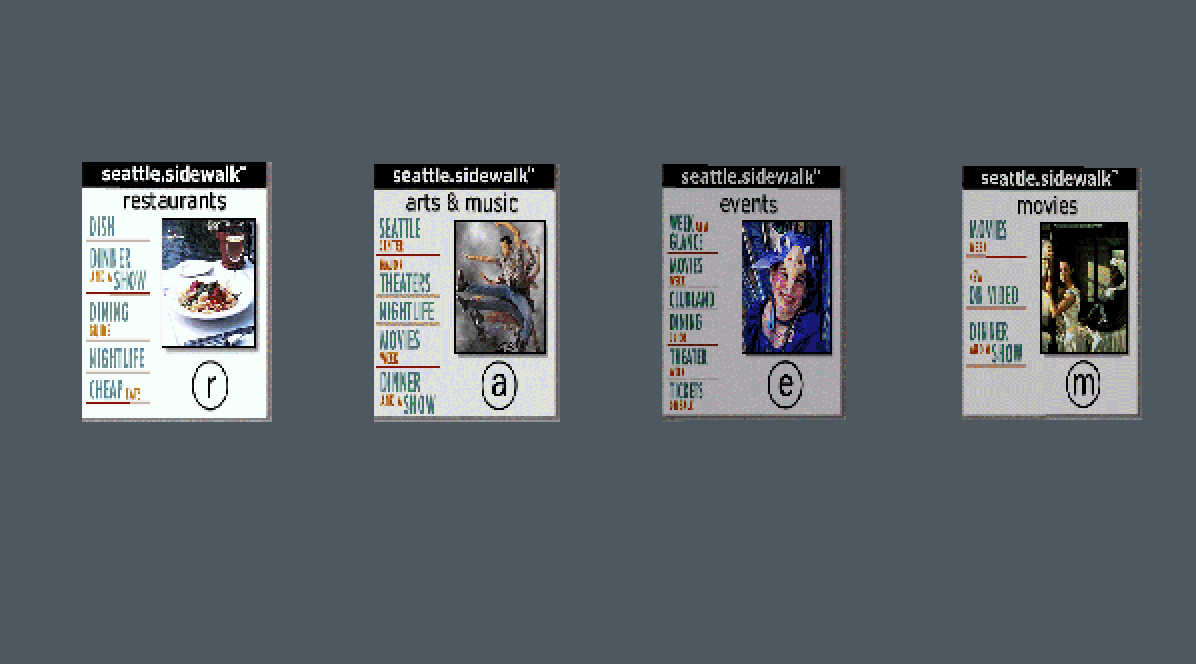
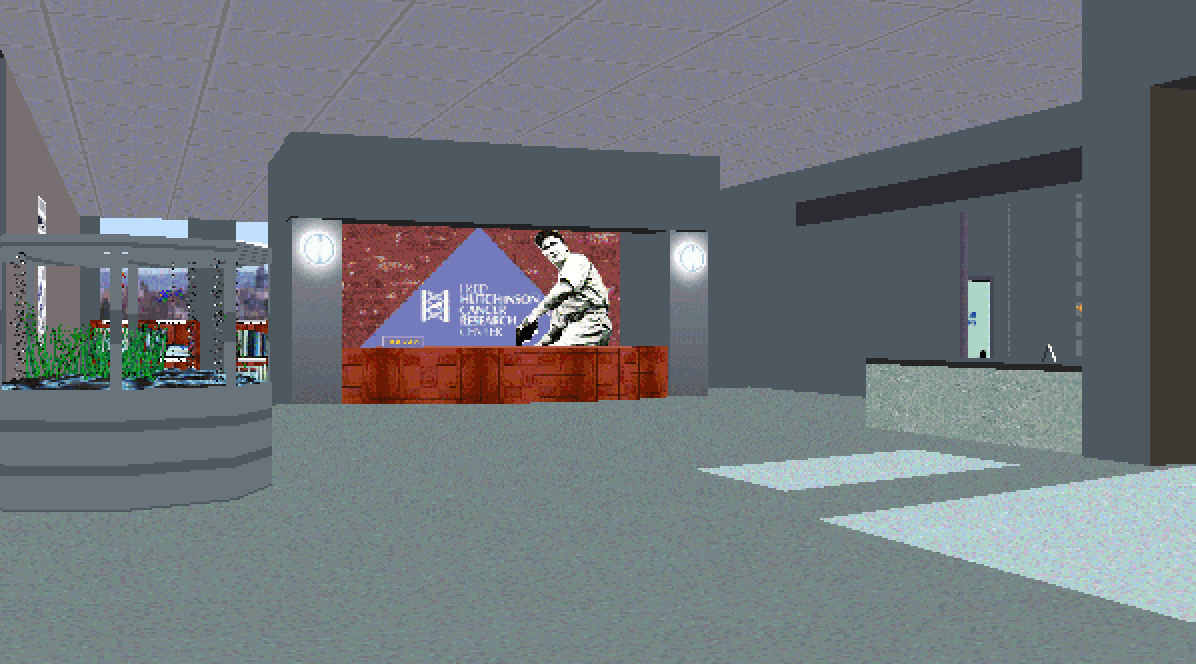
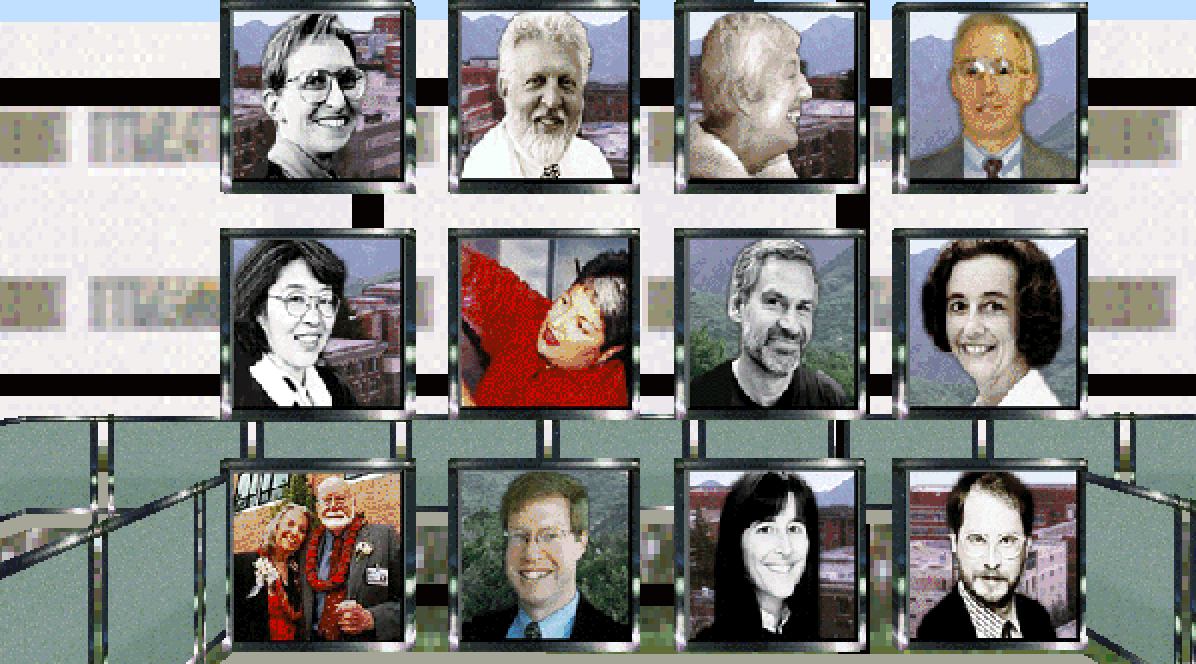
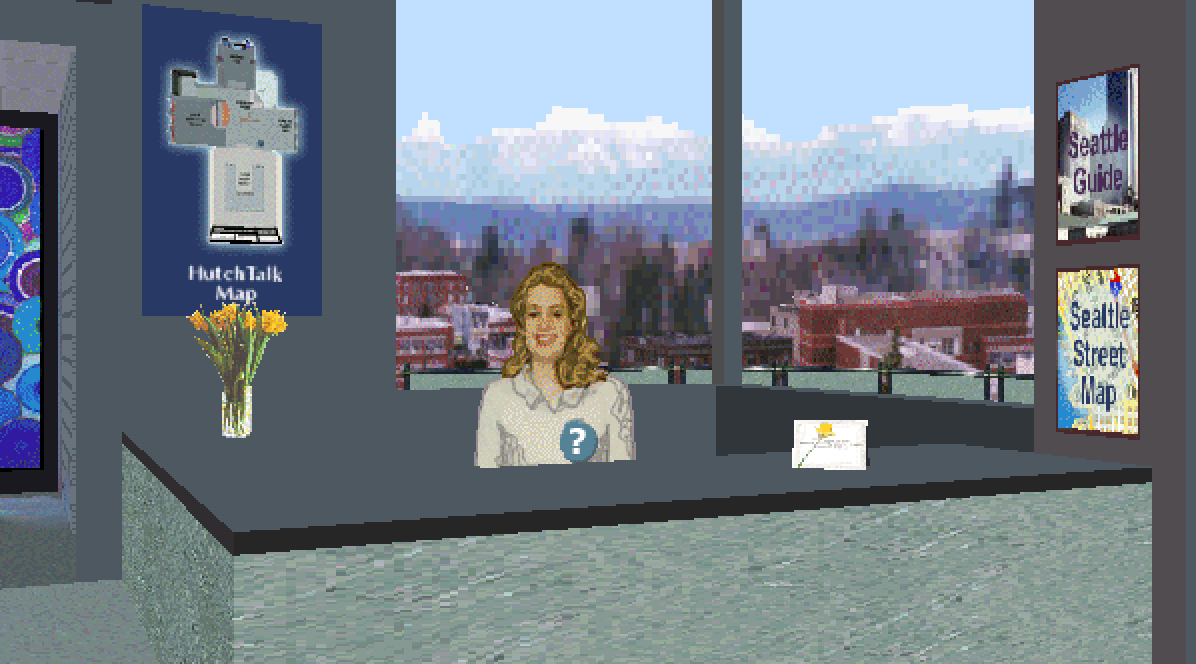
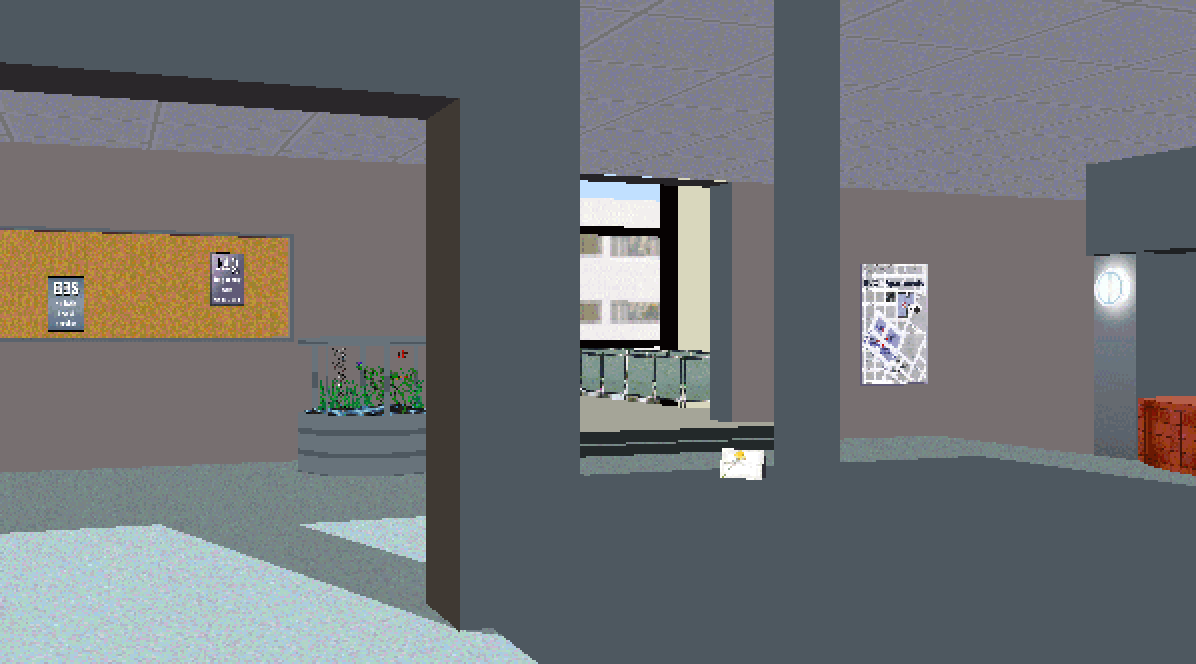
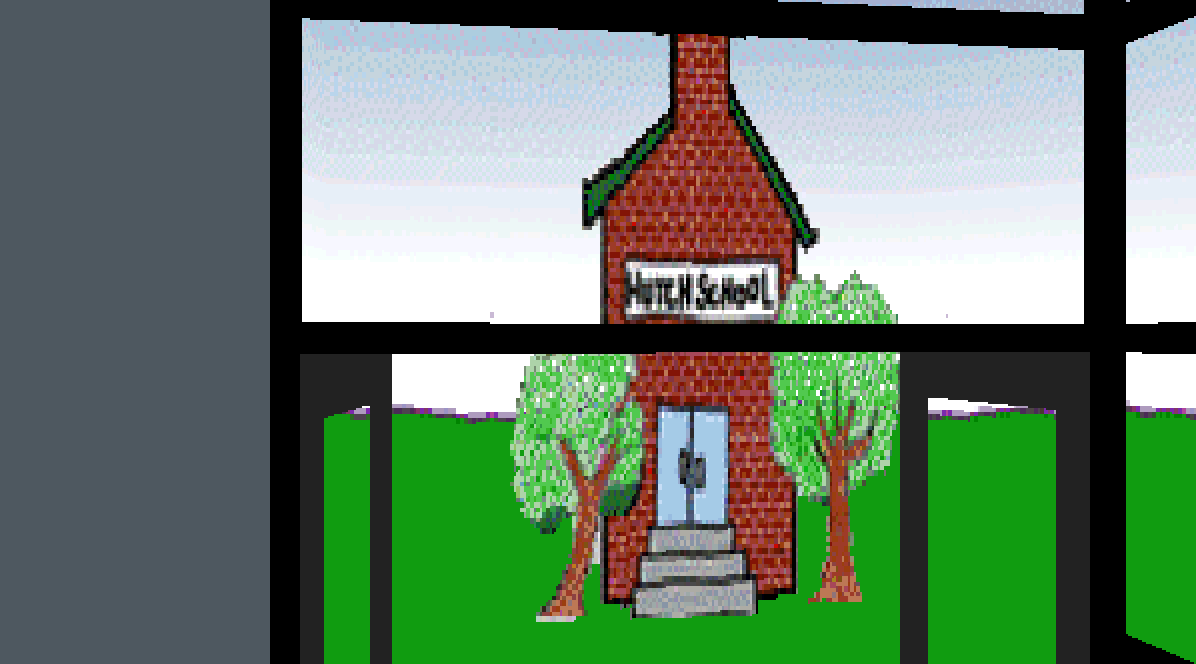
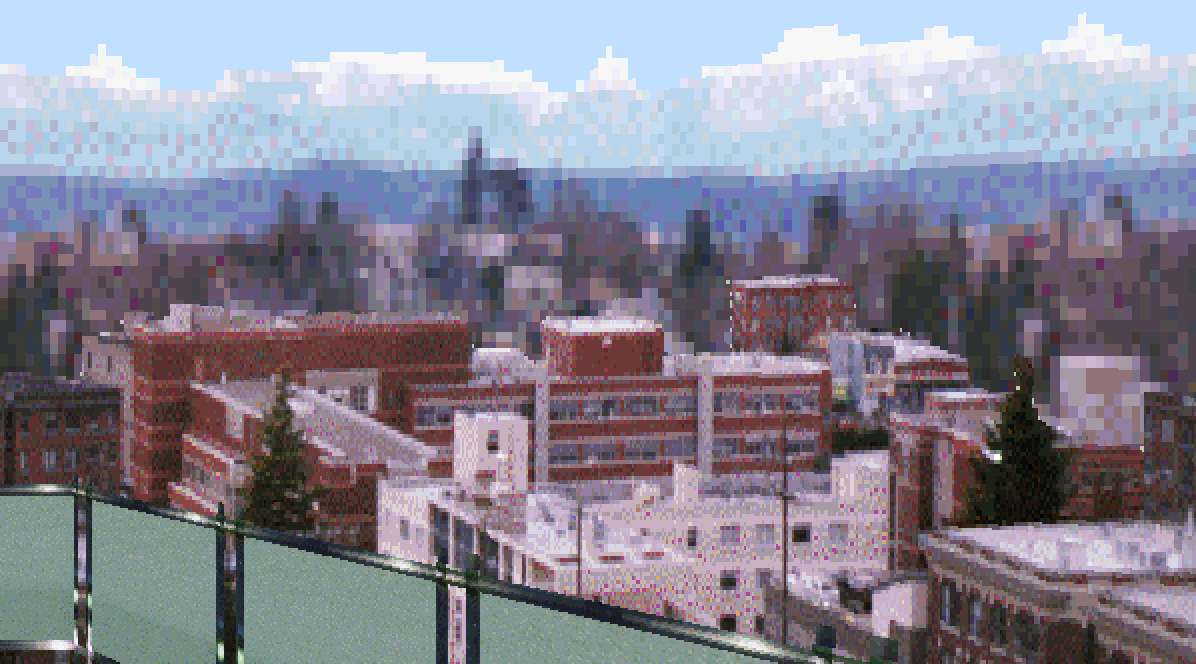
A world based on the outpatient lobby portion of the Fred Hutchinson Cancer Research Center.
Designed to be a hub of information and support for patients and caregivers of the Hutch, this is by far the most realistic V-Chat world.
It's a very aesthetically pleasing place, with little details like the way the light shines onto the floor and walls through the windows.
It even has a little aquarium that shares its graphics with The Fishbowl!
It was made with the benefit of Microsoft Research, the Hutch and users in mind - for Microsoft, HutchWorld provided a way to conduct important social and technical research. For the Hutch, it would enhance services for its patient community and help to better understand how to plan for future technology integration.
Linda Stone, director of the VWG, approached the Hutch with the idea for this collaboration in the spring of 1997. Ann Marie Clark, Director of the Arnold Library and also responsible for the Hutch Internet sites, ultimately became the Hutch liaison with Microsoft and the project manager for Hutch.
Funding for the project was primarily provided through a charitable donation from Microsoft to the Hutch, which was unusual for Microsoft in that healthcare was outside of the corporation's charitable giving guidelines.
Due to a pre-existing relationship between the Hutch and Microsoft coupled with the potential research opportunities, an exception was made to fund the project.
The original design theme was an abstract Zen garden, but it was confusing and did not relate well with the necessary patient information.
Reviewing the existing content, it was agreed that a realistic design based on a public place where patients gather in the real world would provide a logical, familiar entry place for the virtual world.
The team chose the outpatient lobby portion of the medical building where Hutch patients received treatment.
Initially, preliminary design was executed by a team of three outside contractors while Microsoft/Hutch project managers served as mentors, however the outside team created an ineffective communication layer leading Microsoft and Hutch to determine it would be more effective to work together directly without the contractors.
HutchWorld was not meant to replace existing services, but to provide additional support.
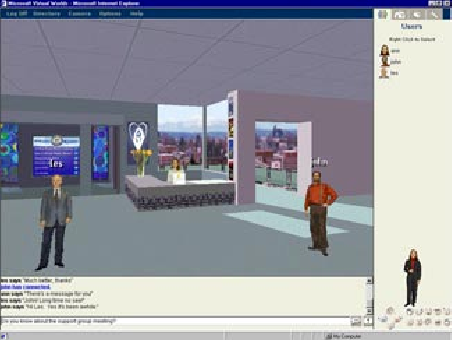
Preliminary Design
Phase 1 of this project involved making a prototype of the concept. Users were to be able to write their own inspirational sayings on the wall, go to the mailroom to send and receive gifts and notes, get free virtual gifts (images of roses, candy, etc.) from the giftshop, and they could access the auditorium, the virtual garden, and the school.
The auditorium was to be based on the real auditorium at the Hutch research facility. An actual presentation given to patients would be shown onstage, and users could click on various documents to view other presentations.
You could enter the virtual garden by walking into a painting. It was supposedly an abstract diversionary space, various animals including butterflies, bugs etc. inhabiting the world.
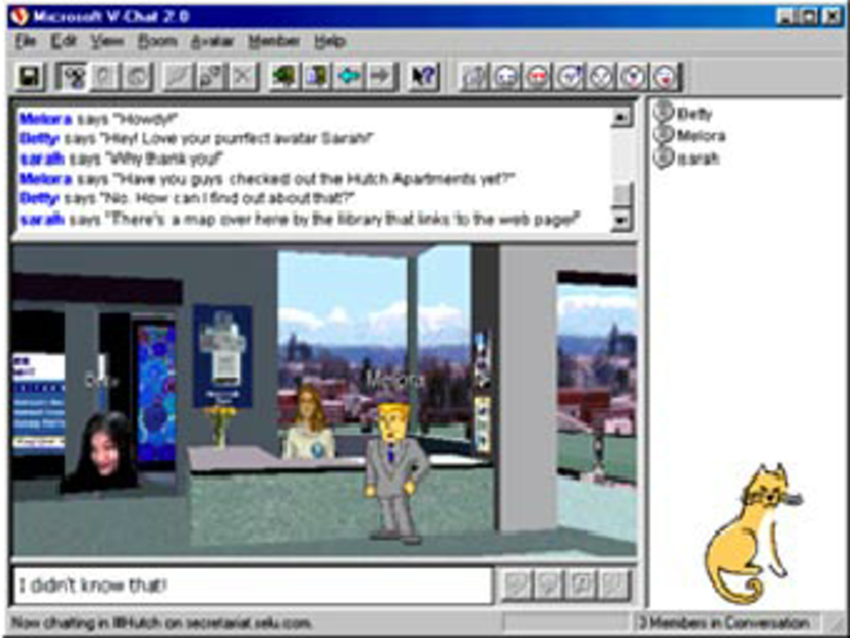
V-Chat Prototype and Deployment
For Phase 2, a simplified version of the technology prototyped in Phase 1 was deployed onto Microsoft V-Chat, a trial that was expected to last as long as six months, though formal support (for hosting, the training of staff, etc.) was ended after only 3 months due to support issues arising from the VWG's over-optimistic expectations.
Parallel to V-Chat deployment, the Hutch was in the process of creating a program to provide project-provided computers and internet access to patients, which were used by participants of the Phase 2 trial.
Dedicated Hutch staff and volunteers were trained in the use of the program, with activities (primarily focused on diversionary activities) were hosted in HutchWorld on a regular schedule.
Only the lobby space was tested in V-Chat, leaving the auditorium and school unbuilt - though the school could still be seen through the windows of this space.
(A hotlink to a world known as "The V-Chat Garden" was still accessible through HutchWorld, though it is unlikely this was the same garden used in the Phase 1 prototype.)
Ultimately, it had many shortcomings: Critical mass in the chatroom was never achieved, the small patient community, staff and volunteers were not interested in standalone synchronous 3D text-chat communication, and the immersive chat experience did not support "lurking" - users felt compelled to talk with one another, as they were now physically present in a virtual space, and patients did not always desire this.
The community was small, and the chatroom was often empty. Users did not return if their first experience was not interesting, and usage was very low.
Still, this taught the VWG a crucial lesson in understanding how to evolve this technology.
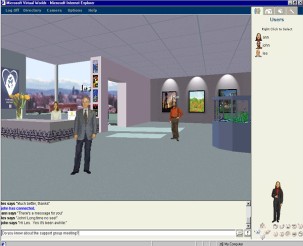
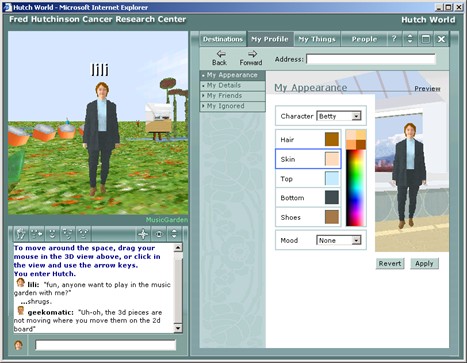
HutchWorld would not return to V-Chat after Phase 2. Formal user tests were performed at Microsoft by useres with a range of computer skills from beginners to experts, and its next public deployment was scheduled to begin in the spring of 2000, beginning with a pilot study followed by a full experiment.
Designed to be a hub of information and support for patients and caregivers of the Hutch, this is by far the most realistic V-Chat world.
It's a very aesthetically pleasing place, with little details like the way the light shines onto the floor and walls through the windows.
It even has a little aquarium that shares its graphics with The Fishbowl!
History of HutchWorld
HutchWorld was a collaboration between Microsoft's Virtual Worlds Group (VWG) and the Fred Hutchinson Cancer Research Center (the Hutch) attempting to provide access to online, computer-mediated social and informational support to immune-compromised patients, their families and caregivers.It was made with the benefit of Microsoft Research, the Hutch and users in mind - for Microsoft, HutchWorld provided a way to conduct important social and technical research. For the Hutch, it would enhance services for its patient community and help to better understand how to plan for future technology integration.
Linda Stone, director of the VWG, approached the Hutch with the idea for this collaboration in the spring of 1997. Ann Marie Clark, Director of the Arnold Library and also responsible for the Hutch Internet sites, ultimately became the Hutch liaison with Microsoft and the project manager for Hutch.
Funding for the project was primarily provided through a charitable donation from Microsoft to the Hutch, which was unusual for Microsoft in that healthcare was outside of the corporation's charitable giving guidelines.
Due to a pre-existing relationship between the Hutch and Microsoft coupled with the potential research opportunities, an exception was made to fund the project.
The original design theme was an abstract Zen garden, but it was confusing and did not relate well with the necessary patient information.
Reviewing the existing content, it was agreed that a realistic design based on a public place where patients gather in the real world would provide a logical, familiar entry place for the virtual world.
The team chose the outpatient lobby portion of the medical building where Hutch patients received treatment.
Initially, preliminary design was executed by a team of three outside contractors while Microsoft/Hutch project managers served as mentors, however the outside team created an ineffective communication layer leading Microsoft and Hutch to determine it would be more effective to work together directly without the contractors.
HutchWorld was not meant to replace existing services, but to provide additional support.

Preliminary Design
Phase 1 of this project involved making a prototype of the concept. Users were to be able to write their own inspirational sayings on the wall, go to the mailroom to send and receive gifts and notes, get free virtual gifts (images of roses, candy, etc.) from the giftshop, and they could access the auditorium, the virtual garden, and the school.
The auditorium was to be based on the real auditorium at the Hutch research facility. An actual presentation given to patients would be shown onstage, and users could click on various documents to view other presentations.
You could enter the virtual garden by walking into a painting. It was supposedly an abstract diversionary space, various animals including butterflies, bugs etc. inhabiting the world.

V-Chat Prototype and Deployment
For Phase 2, a simplified version of the technology prototyped in Phase 1 was deployed onto Microsoft V-Chat, a trial that was expected to last as long as six months, though formal support (for hosting, the training of staff, etc.) was ended after only 3 months due to support issues arising from the VWG's over-optimistic expectations.
Parallel to V-Chat deployment, the Hutch was in the process of creating a program to provide project-provided computers and internet access to patients, which were used by participants of the Phase 2 trial.
Dedicated Hutch staff and volunteers were trained in the use of the program, with activities (primarily focused on diversionary activities) were hosted in HutchWorld on a regular schedule.
Only the lobby space was tested in V-Chat, leaving the auditorium and school unbuilt - though the school could still be seen through the windows of this space.
(A hotlink to a world known as "The V-Chat Garden" was still accessible through HutchWorld, though it is unlikely this was the same garden used in the Phase 1 prototype.)
Ultimately, it had many shortcomings: Critical mass in the chatroom was never achieved, the small patient community, staff and volunteers were not interested in standalone synchronous 3D text-chat communication, and the immersive chat experience did not support "lurking" - users felt compelled to talk with one another, as they were now physically present in a virtual space, and patients did not always desire this.
The community was small, and the chatroom was often empty. Users did not return if their first experience was not interesting, and usage was very low.
Still, this taught the VWG a crucial lesson in understanding how to evolve this technology.


HutchWorld would not return to V-Chat after Phase 2. Formal user tests were performed at Microsoft by useres with a range of computer skills from beginners to experts, and its next public deployment was scheduled to begin in the spring of 2000, beginning with a pilot study followed by a full experiment.
WANTED
HutchWorld had associated avatars, but the files for this world were retrieved well after the avatars were no longer being hosted on-line.If anyone has backups and can supply these avatars for the sake of preservation, please contact me here!
Also, if you can identify who anyone on the wall of portraits is, let me know!
Known Avatar Names
butch, carol, clip,damian, dave, gash,
guy, lady, lump,
mark, roach, rocky,
shadow, tully
Click Here to download Hutchspace
In-World Links
Clicking on the secretary at the desk would take you to the HutchTalk Help Webpage, and the map on the wall would open a larger map of the space.
The Seattle Street Map took you to an online view of the traffic in Seattle at seattle.sidewalk.com, and the Seattle Guide took you to, as the name suggests, an official Hutch Guide to Seattle.
There is a room advertising Free Email provided by Hotmail, naturally leading to hotmail.com.
The Hutch Apartments poster would of course take you to a page on Hutch housing.
The Hutch School graphic is clickable, but has no address associated with it.
The library's bookshelves housed a very, very wide range of links to various pages for cancer information sources, donor programs and other such support.
The gift shop would take you to greeting-cards.com
The bulletin board hosted links to the official Hutch BBS and FAQ.
The seattle.sidewalk posters on the wall take you to even more information on Seattle - local restaurants, arts & music, events, movies and more.
The paintings on the wall are also links - The leftmost one takes you to a guide of Places to Go and the rightmost one takes you to a guide on recreational activities, both also hosted on seattle.sidewalk.
The center painting would take you to a world called The V-Chat Garden.
All of the portraits of people are clickable, but have no associated links.
Additional Notes/Information
The information on this page is sourced & summarized from the lecture notes "Virtual Worlds: Second International Conference, VW 2000 Paris, France, July 5-7, 2000 Proceedings"
Clicking on the secretary at the desk would take you to the HutchTalk Help Webpage, and the map on the wall would open a larger map of the space.
The Seattle Street Map took you to an online view of the traffic in Seattle at seattle.sidewalk.com, and the Seattle Guide took you to, as the name suggests, an official Hutch Guide to Seattle.
There is a room advertising Free Email provided by Hotmail, naturally leading to hotmail.com.
The Hutch Apartments poster would of course take you to a page on Hutch housing.
The Hutch School graphic is clickable, but has no address associated with it.
The library's bookshelves housed a very, very wide range of links to various pages for cancer information sources, donor programs and other such support.
The gift shop would take you to greeting-cards.com
The bulletin board hosted links to the official Hutch BBS and FAQ.
The seattle.sidewalk posters on the wall take you to even more information on Seattle - local restaurants, arts & music, events, movies and more.
The paintings on the wall are also links - The leftmost one takes you to a guide of Places to Go and the rightmost one takes you to a guide on recreational activities, both also hosted on seattle.sidewalk.
The center painting would take you to a world called The V-Chat Garden.
All of the portraits of people are clickable, but have no associated links.
Additional Notes/Information
The information on this page is sourced & summarized from the lecture notes "Virtual Worlds: Second International Conference, VW 2000 Paris, France, July 5-7, 2000 Proceedings"